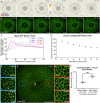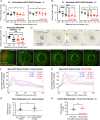After wounding, a G-protein coupled receptor promotes the restoration of tension in epithelial cells
- PMID: 38536445
- PMCID: PMC11151093
- DOI: 10.1091/mbc.E23-05-0204
After wounding, a G-protein coupled receptor promotes the restoration of tension in epithelial cells
Abstract
The maintenance of epithelial barrier function involves cellular tension, with cells pulling on their neighbors to maintain epithelial integrity. Wounding interrupts cellular tension, which may serve as an early signal to initiate epithelial repair. To characterize how wounds alter cellular tension we used a laser-recoil assay to map cortical tension around wounds in the epithelial monolayer of the Drosophila pupal notum. Within a minute of wounding, there was widespread loss of cortical tension along both radial and tangential directions. This tension loss was similar to levels observed with Rok inactivation. Tension was subsequently restored around the wound, first in distal cells and then in proximal cells, reaching the wound margin ∼10 min after wounding. Restoring tension required the GPCR Mthl10 and the IP3 receptor, indicating the importance of this calcium signaling pathway known to be activated by cellular damage. Tension restoration correlated with an inward-moving contractile wave that has been previously reported; however, the contractile wave itself was not affected by Mthl10 knockdown. These results indicate that cells may transiently increase tension and contract in the absence of Mthl10 signaling, but that pathway is critical for fully resetting baseline epithelial tension after it is disrupted by wounding.
Figures






Update of
-
After wounding, a G-protein coupled receptor promotes the restoration of tension in epithelial cells.bioRxiv [Preprint]. 2024 Feb 18:2023.05.31.543122. doi: 10.1101/2023.05.31.543122. bioRxiv. 2024. Update in: Mol Biol Cell. 2024 May 1;35(5):ar66. doi: 10.1091/mbc.E23-05-0204. PMID: 37398151 Free PMC article. Updated. Preprint.
References
-
- Brand AH, Perrimon N (1993). Targeted gene expression as a means of altering cell fates and generating dominant phenotypes. Development 118, 401–415. - PubMed
MeSH terms
Substances
Grants and funding
LinkOut - more resources
Full Text Sources
Molecular Biology Databases
Research Materials

